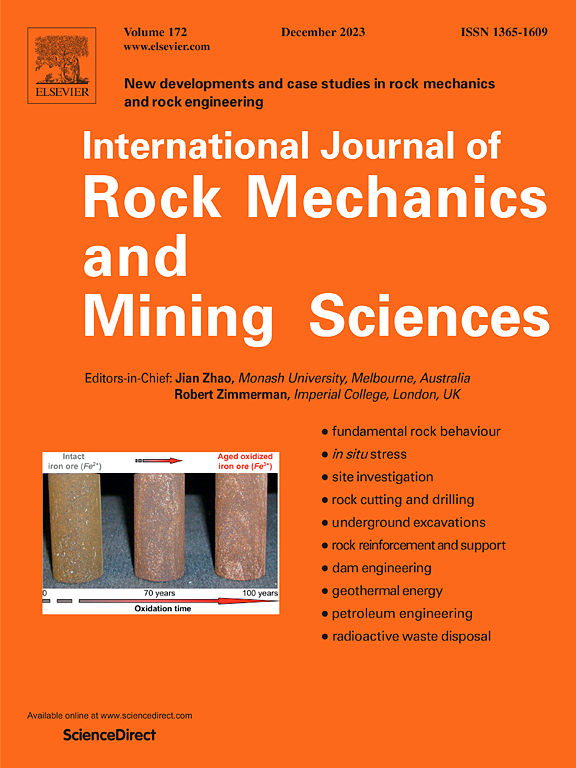Determination of the REV size for heterogeneous rocks with different grain sizes: Deep learning and numerical approaches
IF 7
1区 工程技术
Q1 ENGINEERING, GEOLOGICAL
International Journal of Rock Mechanics and Mining Sciences
Pub Date : 2024-10-24
DOI:10.1016/j.ijrmms.2024.105940
引用次数: 0
Abstract
Accurate determination of the representative elementary volume (REV) size plays a pivotal role in analysing the mechanical properties and failure processes of heterogeneous rocks in complex engineering environments. In this study, a novel microstructure modelling strategy (NMMS) for determining the REV size is proposed by combining deep learning and an improved phase-field method (PFM). Micro- and macroscale experiments are systematically conducted to determine the real microstructural characteristics and mechanical properties of heterogeneous rocks with different grain sizes. On the basis of this experimental evidence, geometric models of different sizes were reconstructed through deep learning to avoid the limitations of human-based methods, and an improved PFM was used for numerical calculations. These models were then employed to perform numerical tests under uniaxial loading conditions, and the coefficient of variation was introduced to determine the REV size of heterogeneous rocks with different grain sizes. The research findings indicate that the final REV size is the maximum value of the REVs defined by the evaluation properties within an acceptable coefficient of variation. At a criterion of 5% for the coefficient of variation, the REV sizes are 60 mm60 mm, 70 mm70 mm, and 90 mm90 mm for fine-medium-grained (FMG), medium-grained (MG), and coarse-grained (CG) rocks, respectively. Furthermore, the REV determined by the NMMS was applied to investigate the effects of microstructure on macromechanical properties and damage evolution under triaxial loading conditions. The numerical results show that the NMMS can accurately predict the macromechanical properties and microcracking patterns of heterogeneous rocks, especially the intracrystalline cracks in feldspar, the interfacial cracks in gravel, and the “voids” of cracks in biotite. This research can provide some basic references for the optimal choice of the REV size of heterogeneous rocks.
确定具有不同粒度的异质岩石的 REV 尺寸:深度学习和数值方法
准确确定代表性基本体积(REV)尺寸对分析复杂工程环境中异质岩石的力学性能和破坏过程起着至关重要的作用。本研究结合深度学习和改进的相场法(PFM),提出了一种用于确定 REV 尺寸的新型微结构建模策略(NMMS)。研究系统地进行了微观和宏观实验,以确定具有不同晶粒尺寸的异质岩石的真实微观结构特征和力学性能。在此实验证据的基础上,通过深度学习重建了不同粒度的几何模型,以避免人为方法的局限性,并使用改进的 PFM 进行数值计算。然后利用这些模型在单轴加载条件下进行数值试验,并引入变异系数来确定不同粒度的异质岩石的 REV 尺寸。研究结果表明,最终的 REV 尺寸是在可接受的变异系数范围内,由评价特性定义的 REV 的最大值。在变异系数为 5%的标准下,细中粒(FMG)、中粒(MG)和粗粒(CG)岩石的 REV 尺寸分别为 60 毫米×60 毫米、70 毫米×70 毫米和 90 毫米×90 毫米。此外,在三轴加载条件下,应用 NMMS 确定的 REV 研究了微结构对宏观力学性能和损伤演化的影响。数值结果表明,NMMS 可以准确预测异质岩石的宏观力学性能和微裂纹形态,尤其是长石的晶内裂纹、砾石的界面裂纹和生物岩的 "空洞 "裂纹。这项研究可为异质岩 REV 尺寸的最佳选择提供一些基本参考。
本文章由计算机程序翻译,如有差异,请以英文原文为准。
求助全文
约1分钟内获得全文
求助全文
来源期刊
CiteScore
14.00
自引率
5.60%
发文量
196
审稿时长
18 weeks
期刊介绍:
The International Journal of Rock Mechanics and Mining Sciences focuses on original research, new developments, site measurements, and case studies within the fields of rock mechanics and rock engineering. Serving as an international platform, it showcases high-quality papers addressing rock mechanics and the application of its principles and techniques in mining and civil engineering projects situated on or within rock masses. These projects encompass a wide range, including slopes, open-pit mines, quarries, shafts, tunnels, caverns, underground mines, metro systems, dams, hydro-electric stations, geothermal energy, petroleum engineering, and radioactive waste disposal. The journal welcomes submissions on various topics, with particular interest in theoretical advancements, analytical and numerical methods, rock testing, site investigation, and case studies.

 求助内容:
求助内容: 应助结果提醒方式:
应助结果提醒方式:


